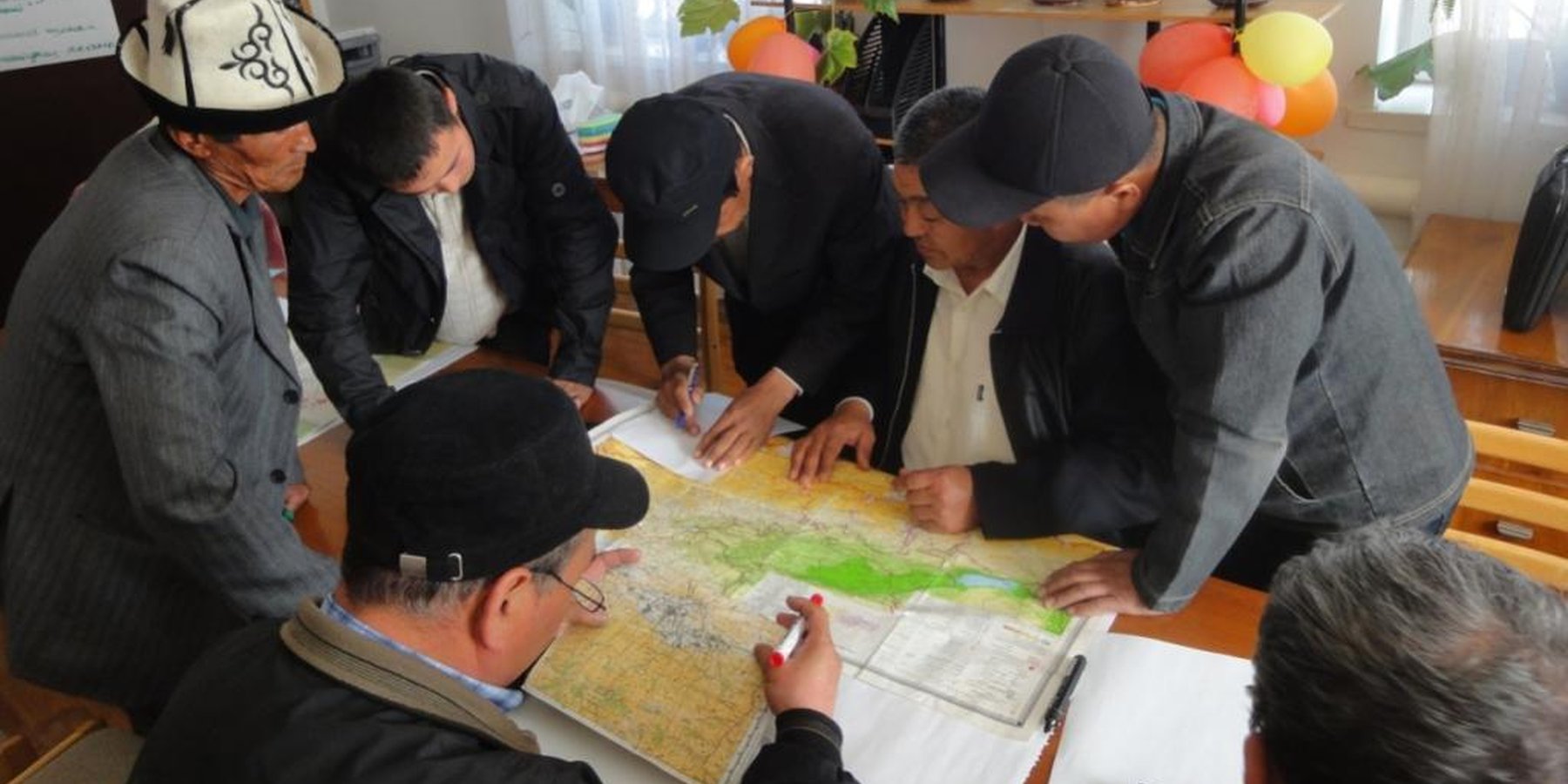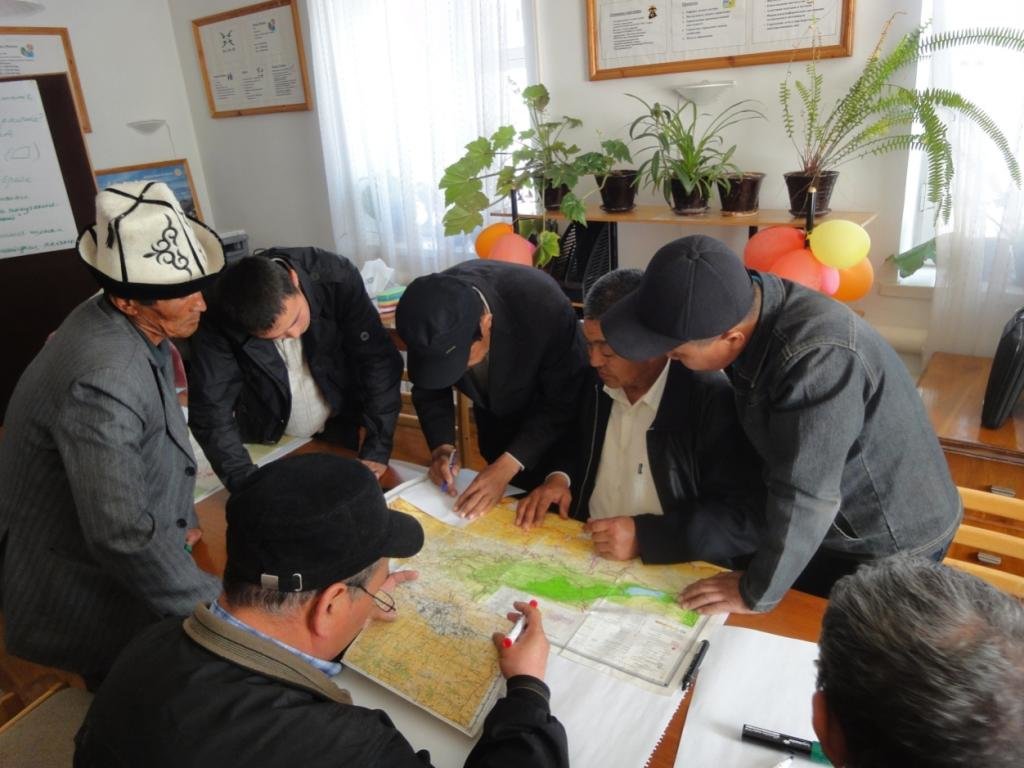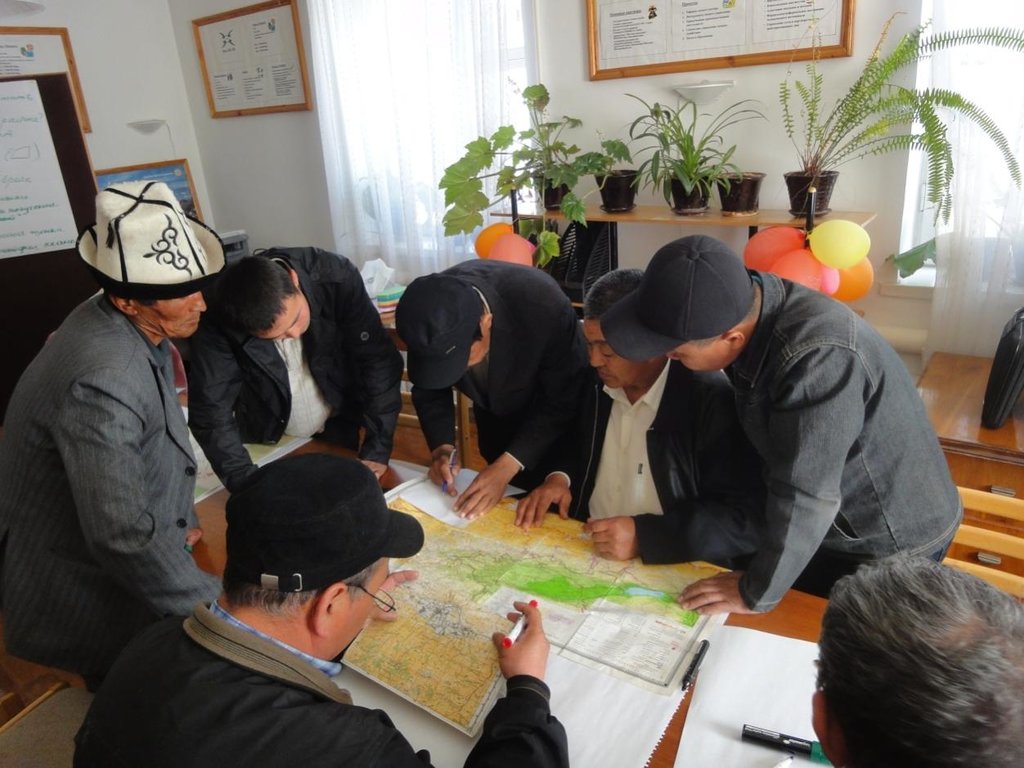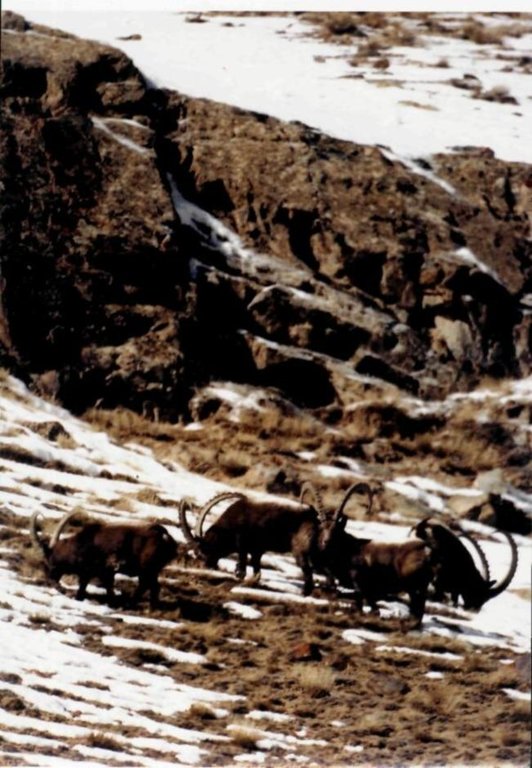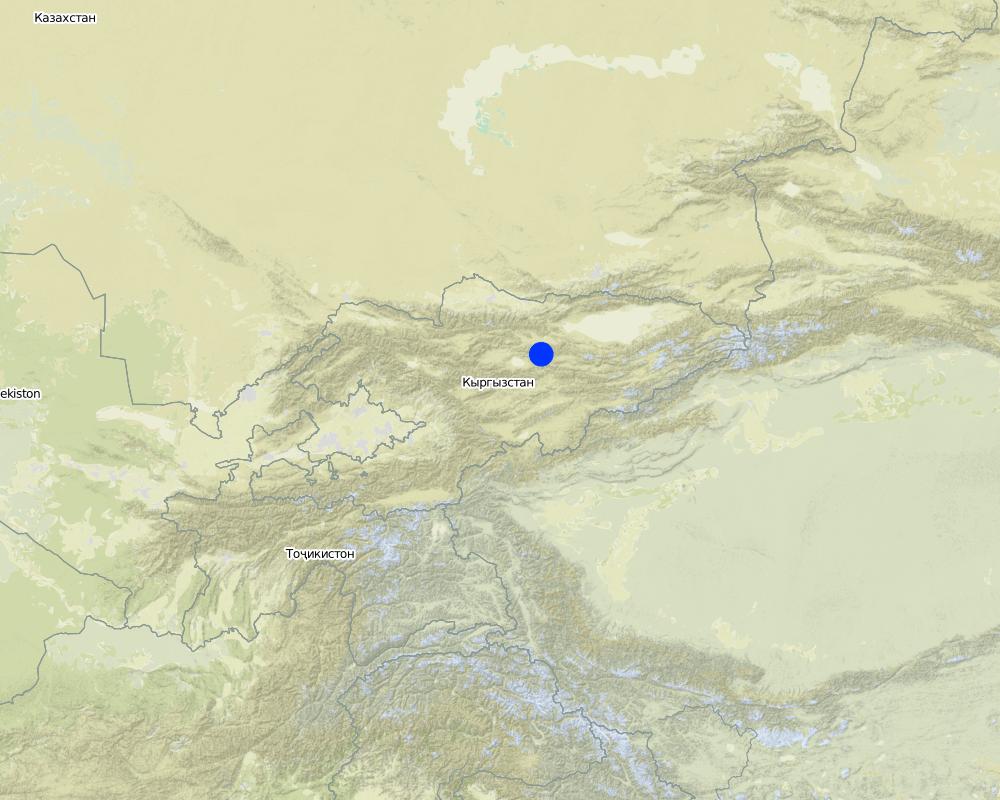Joint Wildlife Management in the mountain ecosystem of the Naryn region in Kyrgyzstan [ກີກັດຕັນ]
- ການສ້າງ:
- ປັບປູງ:
- ຜູ້ສັງລວມຂໍ້ມູນ: Nazgul Esengulova
- ບັນນາທິການ: –
- ຜູ້ທົບທວນຄືນ: Alexandra Gavilano, David Streiff
Нарын областында тоолуу экосистемаларынын табигый анчылык ресурстарын жергиликтуу жамааттардын негизинде колдонуу
approaches_2582 - ກີກັດຕັນ
ເບິ່ງພາກສ່ວນ
ຂະຫຍາຍທັງໝົດ ຍຸບທັງໝົດ1. ຂໍ້ມູນທົ່ວໄປ
1.2 ລາຍລະອຽດ ການຕິດຕໍ່ ຂອງບຸກຄົນທີ່ຊັບພະຍາກອນ ແລະ ສະຖາບັນ ການມີສ່ວນຮ່ວມ ໃນການປະເມີນຜົນ ແລະ ເອກະສານ ຂອງວິທີທາງ
ຜູ້ຊ່ຽວຊານ ດ້ານການຄຸ້ມຄອງ ທີ່ດິນແບບຍືນຍົງ:
ຊື່ຂອງ ສະຖາບັນການຈັດຕັ້ງ ທີ່ອໍານວຍຄວາມສະດວກ ໃນການສ້າງເອກກະສານ ຫຼື ປະເມີນແນວທາງ (ຖ້າກ່ຽວຂ້ອງ)
Deutsche Gesellschaft für Internationale Zusammenarbeit (GIZ) GmbH (GIZ) - ເຢຍລະມັນ1.3 ເງື່ອນໄຂ ຂອງການນໍາໃຊ້ເອກກະສານຂໍ້ມູນ ຂອງ WOCAT
ເມື່ອໃດທີ່ໄດ້ສັງລວມຂໍ້ມູນ (ຢູ່ພາກສະໜາມ)?
11/05/2012
ຜູ້ສັງລວມ ແລະ ບັນດາຜູ້ຕອບແບບສອບຖາມ ຍອມຮັບໃນເງື່ອນໄຂ ການນໍາໃຊ້ຂໍ້ມູນເອກະສານ ທີ່ສ້າງຂື້ນ ໂດຍຜ່ານ ອົງການ WOCAT:
ແມ່ນ
2. ພັນລະນາ ແນວທາງການຄຸ້ມຄອງນໍາໃຊ້ດິນແບບຍືນຍົງ
2.1 ການອະທິບາຍ ໂດຍຫຍໍ້ ຂອງວິທີທາງ
Joint Wildlife Management based on economic empowerment and assigning hunting (wildlife) grounds to the Association of local hunters and providing her with user rights for game resources leads to a sustainable use of natural resources and biodiversity and wildlife conservation (in the frame of CACILM).
2.2 ການອະທິບາຍ ລາຍລະອຽດ ຂອງວິທີທາງ
ການອະທິບາຍ ລາຍລະອຽດ ຂອງວິທີທາງ:
Aims / objectives: Wildlife in Kyrgyzstan, especially mountain ungulates, is threatened because these resources can be easily accessed due to an inadequate state supervision and regulation as well as due to lack of knowledge among the local population and mechanism for integrated land use (considering different coordinated types of resource use) and resource conservation. Decrease in the natural habitat (caused by the expansion of pasture and arable land) and illegal hunting lead to a decrease in wildlife populations. In Kyrgyzstan, the fauna is exclusively owned by the state. User rights for wildlife are separated from land use ones. The approach aims at the conservation and sustainable use of wildlife based on providing representatives of the local community, organized in an Association of local hunters (ALH), with legal user rights for wildlife resources.
Methods: (1) supporting local hunters in organizing an Association of local hunters (ALH) with the help of facilitators; (2) transferring wildlife management functions from the Wildlife Department to the ALH based on assigning hunting grounds to them and providing them with user rights according to jointly developed management plans; (3) building trust in partnership relations between the ALH and the Wildlife Department of State Agency for Environmental Protection and Forestry (SAEPF) based on joint registration and monitoring and determination of the resource status (see Annex 3); (4) capacity building of the ALH with the help of independent experts and advising activities provided by the Wildlife Department; (5) developing an atmosphere of trust by establishing links between the Wildlife Department, local hunters (ALH), the local community (Aiylokmotu) and rural organizations (Pasture User Association, PUA) based on joint planning and information sharing.
Stages of implementation: (1) setting up groups of well-trained (sensitive) facilitators and training them on the principles of facilitation, conflict management and sustainable management of natural resources; (2) identifying reliable active hunters with the help of facilitators and managers by interviewing neutral people; (3) organizing a meeting at the field level to analyze the situation and identify interests in establishing of the ALH; (4) raising awareness of local hunters on wildlife resources, existing problems and possible solutions offered by sustainable management; (5) establishing an ALH in the pilot area as a legal entity; (6) assigning areas to the ALH and advising activities on methods for wildlife management provided by the Wildlife Department and the specialized NGO 'Ak-Terek'; (7) organizing expeditions with specialists from the Wildlife Department to register and monitor the resource status; (8) developing a management plan with the support of experts from the Wildlife Department and independent experts, plan approval and implementation.
2.3 ຮູບພາບຂອງແນວທາງ
2.5 ປະເທດ / ເຂດ / ສະຖານທີ່ບ່ອນທີ່ແນວທາງໄດ້ຖືກນໍາໃຊ້
ປະເທດ:
ກີກັດຕັນ
ພາກພື້ນ / ລັດ / ແຂວງ:
Kyrgyzstan, Naryn oblast
ຂໍ້ມູນເພີ່ມເຕີມຂອງສະຖານທີ່:
Kochkor district, Toloksky Aiylokmotu (villages Tolok and Kok-Jar)
ຄວາມຄິດເຫັນ:
Tolok village is situated at 2343 meters above sea level. Hunting grounds are located in the basin of Tolok river in a narrow gorge in the area of alpine meadows with a middle degree of soil degradation. The area is inhabited by wild mountain goats, deer, wolves, foxes, marmots, hares, partridges.
Map
×2.6 ວັນທີເລີ່ມຕົ້ນ ແລະ ສິ້ນສຸດ ການຈັດຕັ້ງປະຕີບັດ ວິທີທາງ
ສະແດງປີຂອງການເລີ່ມຕົ້ນ:
2010
ປີທີ່ສີ້ນສູດ (ຖ້າຢຸດບໍ່ໄດ້ນໍາໃຊ້ ວິທີທາງ):
2014
2.7 ປະເພດຂອງແນວທາງ
- ພາຍໃຕ້ໂຄງການ / ແຜນງານ
2.8 ເປົ້າໝາຍ / ຈຸດປະສົງຫຼັກ ຂອງການຈັດຕັ້ງປະຕິບັດ ວິທີທາງ
The Approach focused mainly on other activities than SLM (Transferring responsibilities of wildlife management to the local population, assigning hunting grounds to the Association of local Hunters and providing her with legal user rights for game resources, sustainable management of wildlife and joint planning)
The approach aims at conservation and sustainable use of wildlife based on economic empowerment and transfer of legal use rights for wildlife resources to representatives of the local community, organized in the Association of local hunters according to jointly developed management plans.
The SLM Approach addressed the following problems: Decrease in wildlife populations due to an unregulated unsustainable use of resources by the local population and due to lack of participatory mechanisms for the population to manage these resources, inadequate state regulation and supervision, aggravated by a conflict of interest among users over other natural resources with different intentions (pasture, forest, mineral resources, tourism).
2.9 ເງື່ອນໄຂອໍານວຍ ຫຼື ຂັດຂວາງການປະຕິບັດຂອງເຕັກໂນໂລຢີ / ເຕັກໂນໂລຢີການນໍາໃຊ້ຕາມແນວທາງ
ສັງຄົມ / ວັດທະນະທໍາ / ມາດຕະຖານ ແລະ ຄຸນຄ່າທາງສາສະໜາ
- ເຊື່ອງຊ້ອນ
Hunting is basically illegal. Local hunters do not trust the new approach of wildlife management and have no capacity for self-organization and no experience of joint decision making.
Treatment through the SLM Approach: Providing necessary information to the local population by holding meetings and seminars with representatives of the Wildlife Department. Trainings on capacity building for self-organization.
ມີຄວາມສາມາດ / ເຂັ້າເຖິງຊັບພະຍາກອນດ້ານການເງິນ ແລະ ການບໍລິການ
- ເຊື່ອງຊ້ອນ
There is a need for initial investment to get the ALH started and deferred revenues are expected. The ALH is not expected to extract big financial revenues from wildlife management and wildlife use.
Treatment through the SLM Approach: Explanation of financial expectations (exclusive right of first access to game resources and authority of access right distribution, patriotism)
ການກໍ່ຕັ້ງສະຖາບັນ
- ເຊື່ອງຊ້ອນ
There is a lack of joint organizations at the field level which manage wildlife resources sustainably.
Treatment through the SLM Approach: Establishing an Association of local hunters to manage wildlife resources sustainably
ກ່ຽວກັບກົດໝາຍ (ສິດນໍາໃຊ້ດິນ, ສິດນໍາໃຊ້ນໍ້າ)
- ອໍານວຍ
- ເຊື່ອງຊ້ອນ
There is a lack of policy promoting Joint Wildlife Management
Treatment through the SLM Approach: Order of the Wildlife Department, Concept of Reform for wildlife sector prohibiting state agencies to manage wildlife economically, promoting the assignment of wildlife areas to the ALH
The existing land ownership, land use rights / water rights greatly hindered the approach implementation Existing legislation does not comply with the principles of sustainable use and wildlife management and does not promote Joint Wildlife Management. There is a lack of regulation and integration of land users.
ຄວາມຮູ້ກ່ຽວກັບການຄຸ້ມຄອງ ທີ່ດິນແບບຍືນຍົງ, ການເຂົ້າເຖິງການສະໜັບສະໜູນ ທາງດ້ານວິຊາການ
- ເຊື່ອງຊ້ອນ
The local population has no necessary capacities (environmental awareness, knowledge of sustainable wildlife management).
Treatment through the SLM Approach: Trainings
3. ການມີສ່ວນຮ່ວມ ແລະ ບົດບາດຂອງພາກສ່ວນທີ່ກ່ຽວຂ້ອງທີ່ໄດ້ມີສ່ວນຮ່ວມ
3.1 ຜູ້ມີສ່ວນຮ່ວມ ໃນວິທີທາງ ແລະ ພາລະບົດບາດ ຂອງເຂົາເຈົ້າ
- ຜູ້ນໍາໃຊ້ດິນໃນທ້ອງຖິ່ນ / ຊຸມຊົນທ້ອງຖິ່ນ
Hunters from the villages Kok-Djar and Tolel in the Naryn region
Hunting is a traditionally male-dominated activity
Pasture user committees
- ອົງການຈັດຕັ້ງ ພາຍໃນຊຸມຊົນ
- ອົງການຈັດຕັ້ງ ທີ່ບໍ່ຂື້ນກັບລັດຖະບານ
Public Foundation “Ak-Terek”
- ພະນັກງານຂັ້ນສູນກາງ (ຜູ້ວາງແຜນ, ຜູ້ສ້າງນະໂຍບາຍ)
Wildlife Department of SAEPF
- ອົງການຈັດຕັ້ງ ສາກົນ
GIZ Regional Program on Sustainable Use of Natural Resources via the Project “Sustainable use of the mountain ungulate species in Kyrgyzstan”
3.2 ການມີສ່ວນຮ່ວມຂອງຜູ້ນໍາໃຊ້ທີ່ດິນໃນທ້ອງຖິ່ນ / ຊຸມຊົນທ້ອງຖິ່ນໃນໄລຍະທີ່ແຕກຕ່າງກັນຂອງແນວທາງ
| ການລວບລວມ ເອົາຜູ້ນໍາໃຊ້ດິນ ໃນທ້ອງຖິ່ນ / ຊຸມຊົນທ້ອງຖິ່ນ | ໃຫ້ລະບຸ ຜູ້ໃດທີ່ມີສ່ວນຮ່ວມ ໃນແຕ່ລະກິດຈະກໍາ? | |
|---|---|---|
| ການເລີ່ມຕົ້ນ / ແຮງຈູງໃຈ | ການຮ່ວມມື | Consulting with the Wildlife Department |
| ການວາງແຜນ | ການຮ່ວມມື | Participation at discussing the approach design and determining the form and specifics of self-organization |
| ການປະຕິບັດ | ການຮ່ວມມື | Local hunters implement the approach through their representatives in the ALH |
| ຕິດຕາມກວດກາ / ການປະເມີນຜົນ | ການຮ່ວມມື | Monitoring and evaluation are conducted on base of questionnaires and interviews with key actors supported by the Wildlife Department and GIZ Project and on base of annual progress assessment in reports prepared for the Wildlife Department (increase in wildlife population, reducing conflicts among resource users). |
| Research | ບໍ່ມີ |
3.3 ແຜນວາດ (ຖ້າມີ)
ການອະທິບາຍ:
The approach has been implemented by the GIZ project 'Sustainable management of the mountain ungulate species' under the Regional Program on Sustainable Use of Natural Resources in Central Asia which initiated and implemented establishment of the ALH in conjunction with the Wildlife Department and the NGO 'Ak-Terek'. The Wildlife Department has developed new methods for monitoring and determining wildlife quotas. The NGO 'Ak-Terek' promotes and facilitates self-organization of hunters in the ALH, mitigate possible conflicts arising in the integrated land use. Local hunters are organized into the ALH, defining her structure and principles of organization (legal status, functions, membership), as well as monitoring and developing management plan, etc. The Wildlife Department confirms the legal assignment of wildlife areas to the ALH and provides advice to them on game management.
ຜູ້ຂຽນ:
Nazgul Esengulova (720001, Logvinenko St., 26а, Bishkek, Kyrgyzstan )
3.4 ການຕັດສິນໃຈກ່ຽວກັບການຄັດເລືອກເຕັກໂນໂລຢີຂອງການຄຸ້ມຄອງທີ່ດິນແບບຍືນຍົງ / ເຕັກໂນໂລຢີ
ໄດ້ຕັດສິນໃຈເລືອກ ເຕັກໂນໂລຢີ (ຫຼາຍ) ບໍ່?
- Experts from the Wildlife Department
ອະທິບາຍ:
In a seminar involving the local population and project experts and experts from the NGO 'Ak-Terek' as facilitators in order to explain the principles of wildlife management.
Decisions on the method of implementing the SLM Technology were made by mainly by land users supported by SLM specialists. Decisions were made by the village population supported by WLD experts.
In the meeting of key hunters, shepherds and other interested residents of the village with the project staff and the Foundation 'Ak-Terek', there was determined a form of local self-organization of wildlife users.
4. ການສະໜັບສະໜູນທາງດ້ານວິຊາການ, ການສ້າງຄວາມສາມາດ, ແລະ ການຈັດການຄວາມຮູ້.
4.1 ການສ້າງຄວາມສາມາດ / ການຝຶກອົບຮົມ
ຜູ້ນໍາໃຊ້ທີ່ດິນ ຫຼື ພາກສ່ວນກ່ຽວຂ້ອງອື່ນໆ ໄດ້ຮັບການຝຶກອົບຮົມບໍ່?
ແມ່ນ
ໃຫ້ລະບຸ ຜູ້ໃດທີ່ໄດ້ຮັບການຝຶກອົບຮົມ:
- ຜູ້ນໍາໃຊ້ດິນ
- Wildlife Department
ຖ້າເປັນໄປໄດ້, ໃຫ້ລະບຸເພດ, ອາຍຸ, ສະຖານະພາບ, ຊົນເຜົ່າ, ແລະ ອື່ນໆ:
Mainly males at age 40-50
ຮູບແບບຂອງການຝຶກອົບຮົມ:
- ການເຮັດຕົວຈິງ
- ຕົວຕໍ່ຕົວ
- ກອງປະຊຸມ
ຮູບແບບຂອງການຝຶກອົບຮົມ:
- 2 day seminars on the spot
ໃນຫົວຂໍ້:
1. Raising awareness of actual problems and possible solutions; joint mapping of resources and discussion of scenarios for development of hunting grounds;
2. Principles of sustainable wildlife use;
3. Methods for monitoring and registering the number of wild animals;
4. Planning economic activities of game management for an assigned area;
5. Professional ethics of game users;
6. Programs for employees of environmental, law enforcement and customs authorities.
4.2 ການບໍລິການໃຫ້ຄໍາປຶກສາ
ເຮັດຜູ້ໃຊ້ທີ່ດິນມີການເຂົ້າເຖິງການບໍລິການໃຫ້ຄໍາປຶກສາ?
ແມ່ນ
ລະບຸວ່າການສະໜອງ ການບໍລິການ ໃຫ້ຄໍາປຶກສາ:
- ໃນພື້ນທີ່ຂອງຜູ້ນໍາໃຊ້ດິນ
ອະທິບາຍ / ຄວາມຄິດເຫັນ:
Name of method used for advisory service: situation analysis; Key elements: on-site visit, group consultation during workshop, preparation of resource map
Advisory service is quite adequate to ensure the continuation of land conservation activities; Department with its local staff and the NGO 'Ak-Terek' are capable to continue providing advisory services after the project finishes.
4.3 ສະຖາບັນການສ້າງຄວາມເຂັ້ມແຂງ (ການພັດທະນາອົງການຈັດຕັ້ງ)
ສະຖາບັນ ໄດ້ຮັບການສ້າງຕັ້ງຂື້ນ ຫຼື ໄດ້ຮັບການສ້າງຄວາມເຂັ້ມແຂງ ໂດຍການຈັດຕັ້ງປະຕິບັດ ວິທີທາງບໍ່?
- ບໍ່ມີ
4.4 ຕິດຕາມກວດກາ ແລະ ປະເມີນຜົນ
ການຈັດຕັ້ງປະຕິບັດ ວິທີທາງ ໄດ້ມີການປະເມີນຜົນ ແລະ ຕິດຕາມບໍ?
ແມ່ນ
ຄວາມຄິດເຫັນ:
Bio-physical aspects were regular monitored by project staff, land users through observations; indicators: expeditions, field researches, surveys
Bio-physical aspects were regular monitored by project staff, land users through measurements; indicators: number of wild animals
Economic / production aspects were regular monitored by project staff through measurements; indicators: benefit from selling hunting tours and ecotourism
No. of land users involved aspects were regular monitored by project staff through measurements; indicators: Number of hunters and associations
Management of Approach aspects were regular monitored by project staff, government through observations; indicators: annual planning, monitoring of achievement and difficulties, adaptation of the approach if necessary
There were no changes in the Approach as a result of monitoring and evaluation
There were no changes in the Technology as a result of monitoring and evaluation
4.5 ການຄົ້ນຄວ້າ
ນີ້້ແມ່ນສ່ວນໜຶ່ງ ການຄົ້ນຄວ້າ ຂອງວິທີທາງບໍ່?
ບໍ່ແມ່ນ
5. ການສະໜັບສະໜູນທາງດ້ານການເງິນ ແລະ ອຸປະກອນຈາກພາຍນອກ
5.1 ງົບປະມານປະຈໍາປີ ສໍາລັບວິທີທາງ ຂອງການຄຸ້ມຄອງ ທີ່ດິນແບບຍືນຍົງ
ຖ້າຫາກບໍ່ຮູ້ຈັດງົບປະມານທີ່ແນ່ນອນ ແມ່ນໃຫ້ປະມານເອົາ:
- 10,000-100,000
ຄໍາເຫັນ (ຕົວຢ່າງ: ແຫຼ່ງຂໍ້ມູນຫຼັກ ຂອງການສະໜອງທຶນ / ຜູ້ໃຫ້ທຶນທີ່ສໍາຄັນ):
Approach costs were met by the following donors: international (GIZ, via “Sustainable use of the mountain ungulate species in Kyrgyzstan” ): 95.0%; government (Wildlife Department of SAEPF): 5.0%; national non-government (PF “Ak-Terek” ); local community / land user(s) (local resource users )
5.2 ການສະໜັບສະໜູນ ທາງດ້ານການເງິນ / ອຸປະກອນ ສະໜອງໃຫ້ແກ່ຜູ້ນໍາທີ່ດິນ
ຜູ້ນໍາໃຊ້ດິນ ໄດ້ຮັບການສະໜັບສະໜູນ ທາງດ້ານ ການເງິນ / ອຸປະກອນ ໃນການຈັດຕັ້ງປະຕິບັດ ເຕັກໂນໂລຢີບໍ?
ບໍ່ແມ່ນ
5.3 ເງິນສົມທົບສໍາລັບການນໍາໃຊ້ສະເພາະປັດໃຈຂາເຂົ້າໃນການຜະລີດກະສິກໍາ (ລວມທັງແຮງງານ)
- ອຸປະກອນ
| ໃຫ້ລະບຸໄດ້ຮັບການສະໜັບສະໜູນປັດໃຈຂາເຂົ້າຫຍັງແດ່ | ທີ່ຂອບເຂດ | ລະບຸ ການອຸດໜູນ |
|---|---|---|
| Tools, binoculars, GPS navigators, tents | ງົບປະມານບາງສ່ວນ | |
ຖ້າແຮງງານ ຂອງຜູ້ນໍາໃຊ້ດິນ ໄດ້ຮັບການສະໜັບສະໜູນ ປັດໃຈຂາເຂົ້າ, ແມ່ນບໍ່:
- ການອາສາ
ຄວາມຄິດເຫັນ:
Voluntary participation in monitoring and registering as well as analyzing wildlife areas for the further assignment of hunting grounds to hunters
5.4 ສິນເຊື່ອ
ໄດ້ປ່ອຍສິນເຊື່ອ ສະໜອງໃຫ້ພາຍໃຕ້ ວິທີການສໍາລັບກິດຈະກໍາ ການຄຸ້ມຄອງ ທີ່ດິນແບບຍືນນຍົງບໍ່?
ບໍ່ແມ່ນ
6. ວິເຄາະຜົນກະທົບ ແລະ ສັງລວມບັນຫາ
6.1 ຜົນກະທົບຂອງແນວທາງ
ການຈັດຕັ້ງປະຕິບັດ ວິທີທາງ ສາມາດຊ່ວຍຜູ້ນໍາໃຊ້ທີ່ດິນ ໃນການຈັດຕັ້ງປະຕິບັດ ແລະ ບໍາລຸງຮັກສາ ເຕັກໂນໂລຢີ ການຄຸ້ມຄອງ ທີ່ດິນແບບຍືນຍົງໄດ້ບໍ?
- ບໍ່
- ມີ, ໜ້ອຍໜຶ່ງ
- ມີ, ພໍສົມຄວນ
- ມີ, ຫຼາຍ
With establishing the Association of local hunters and involving the latter into wildlife management, stabilization and even an increasing tendency of wildlife populations according to ecosystem's carrying capacity have been made possible. Joint planning and activities in the assigned areas decreased the number of conflicts over resources. Diversification of land use and a better integration of land users are present.
ການຈັດຕັ້ງປະຕິບັດ ວິທີທາງ ສາມາດສ້າງຄວາມເຂັ້ມແຂງ ທາງສັງຄົມ ແລະ ເສດຖະກິດບໍ່?
- ບໍ່
- ມີ, ໜ້ອຍໜຶ່ງ
- ມີ, ພໍສົມຄວນ
- ມີ, ຫຼາຍ
ການຈັດຕັ້ງປະຕິບັດ ວິທີທາງ ສາມາດປັບປຸງ ປະເດັນການຖືຄອງທີ່ດິນ / ສິດທິໃນການນໍາໃຊ້ທີ່ດິນ ທີ່ເຊື່ອງຊ້ອນໃນການຈັດຕັ້ງປະຕິບັດ ເຕັກໂນໂລຢີ ການຄຸ້ມຄອງ ທີ່ດິນແບບຍືນຍົງໄດ້ບໍ?
- ບໍ່
- ມີ, ໜ້ອຍໜຶ່ງ
- ມີ, ພໍສົມຄວນ
- ມີ, ຫຼາຍ
Integrating approaches of wildlife management (a relevant order of the Hunting Department) before a new law 'On Hunting' is adopted. Economic empowerment of the LAH and political will for the issue. Increase in sensibility of the main resource users concerning the conservation of biodiversity.
Did other land users / projects adopt the Approach?
- ບໍ່
- ມີ, ໜ້ອຍໜຶ່ງ
- ມີ, ພໍສົມຄວນ
- ມີ, ຫຼາຍ
The project is extended over other areas in Kyrgyzstan (Kemin, Ak-Suu and Talas regions) and in Khatlon and Gorno-Badakhshan oblasts of Tajikistan (Shurabad, Darvaz, Rushan, Ishkakshim, Murghab regions).
Did the Approach lead to improved livelihoods / human well-being?
- ບໍ່
- ມີ, ໜ້ອຍໜຶ່ງ
- ມີ, ພໍສົມຄວນ
- ມີ, ຫຼາຍ
Legally ongoing recreational hunting. Revenue increase resulting from the wildlife protection due to legalization of hunting and sustainable resource management.
Did the Approach help to alleviate poverty?
- ບໍ່
- ມີ, ໜ້ອຍໜຶ່ງ
- ມີ, ພໍສົມຄວນ
- ມີ, ຫຼາຍ
Since the target group does not refer to very poor people
6.2 ແຮງຈູງໃຈຫຼັກຂອງຜູ້ນໍາໃຊ້ທີ່ດິນໃນການປະຕິບັດການຄຸ້ມຄອງທີ່ດິນແບບຍືນຍົງ
- ກໍາໄລເພີ່ມຂຶ້ນ (ຄວາມສາມາດ), ການປັບປຸງຄ່າໃຊ້ຈ່າຍ, ຜົນປະໂຫຍດ, ອັດຕາສ່ວນ
Additional income from hunting tours
- ກົດລະບຽບແລະລະບຽບການ (ລະອຽດ) / ການບັງຄັບໃຊ້
Legalization of hunting
- ກຽດສັກສີ, ຄວາມກົດດັນທາງສັງຄົມ / ການຕິດຕໍ່ກັນທາງສັງຄົມ
Attitude of local people to illegal hunting
- ຄວາມຮັບຮູ້ ທາງສີ່ງແວດລ້ອມ
Moral improvement of society
- well-being and livelihoods improvement
Additional income from hunting tours
- Improvement of ecosystem
Wildlife protection improves the ecosystem where local people live
6.3 ຄວາມຍືນຍົງຂອງກິດຈະກໍາວິທີທາງ
ຜູ້ນໍາໃຊ້ ທີ່ດິນ ສາມາດສືບຕໍ່ ການຈັດຕັ້ງປະຕິບັດ ຜ່ານວິທີທາງໄດ້ບໍ່ (ໂດຍປາດສະຈາກ ການຊ່ວຍເຫຼືອ ຈາກພາກສ່ວນພາຍນອກ)?
- ແມ່ນ
ຖ້າ ໄດ້, ອະທິບາຍເຫດຜົນ:
5 years later, after the number of wild animals in the assigned area is increased. During this period, members of the Association would realize the obvious long-term benefits resulting from the new approach (increasing wildlife population would lead to an increase in hunting licenses issued) and would become experienced in sustainable game management.
6.4 ຈຸດແຂງ / ຂໍ້ດີ ຂອງວິທີທາງ
| ຈຸດແຂງ / ຂໍ້ດີ / ໂອກາດໃນການນໍາໃຊ້ທີ່ດິນ |
|---|
| Opportunity to lobby for own interests through Hunters’ Association in the local community (Aiylokmotu). |
| Opportunity to extract revenue from hunting tours. |
| Opportunity to legalize hunting. |
| Opportunity to manage resources in the assigned area and to plan how to use them. (How to sustain/ enhance this strength: Trainings and expert advice from the Wildlife Department and the Academy of Sciences of KR.) |
| ຈຸດແຂງ / ຈຸດດີ / ໂອກາດ ຈາກທັດສະນະຂອງຜູ້ປ້ອນຂໍ້ມູນ ຫຼື ບຸກຄົນສຳຄັນ |
|---|
| Users of various natural resources (pasture, beekeepers, hunters) jointly plan their activities and use resources. (How to sustain/ enhance this strength: Increasing awareness of the local population on degradation of natural resources and the need for their careful use.) |
| Resource use and management are transferred in the hands of resource users. (How to sustain/ enhance this strength: Adoption of necessary legislation to establish wildlife user associations.) |
| Positive impact on the local ecosystem: stabilization of the wildlife population resulting from of protection of the assigned area and limited shooting. (How to sustain/ enhance this strength: Trainings for hunters on a new method of registration and monitoring of wild animals in order to determine the status of wildlife populations.) |
| Active and regular participation and support of the Wildlife Department in planning and implementing approach and creating an atmosphere of trust. |
6.5 ຈຸດອ່ອນ / ຂໍ້ເສຍຂອງແນວທາງ ແລະ ວິທີການແກ້ໄຂໃຫ້ເຂົາເຈົ້າ
| ຈຸດອ່ອນ / ຂໍ້ເສຍ / ຄວາມສ່ຽງໃນມູມມອງຂອງຜູ້ນໍາໃຊ້ທີ່ດິນ | ມີວິທີການແກ້ໄຂຄືແນວໃດ? |
|---|---|
| Deferred minor revenue over the first years of implementation related to an increase in wildlife populations. | Development of ecotourism as a primary source of income. In the future, ecotourism can be practiced along with hunting tourism, providing additional income. |
| ຈຸດອ່ອນ ຫຼື ຂໍ້ເສຍ ຫຼື ຄວາມສ່ຽງ ໃນມຸມມອງຂອງ ຜູ້ສັງລວມຂໍ້ມູນ ຫຼື ບັນດາຜູ້ຕອບແບບສອບຖາມ | ມີວິທີການແກ້ໄຂຄືແນວໃດ? |
|---|---|
| Resource users have poor capacities for self-organization and are incapable of coherent collective actions. | Consultancy, meetings, involvement of conflict managers and facilitators. |
7. ເອກກະສານອ້າງອີງ ແລະ ຂໍ້ມູນການເຊື່ອມໂຍງ
7.1 ວິທີການ / ແຫຼ່ງຂໍ້ມູນ
- ການໄປຢ້ຽມຢາມພາກສະໜາມ, ການສໍາຫຼວດພາກສະໜາມ
- ການສໍາພາດ ຜູ້ນໍາໃຊ້ທີ່ດິນ
7.2 ເອກະສານທົ່ວໄປທີ່ສາມາດໃຊ້ໄດ້
ຫົວຂໍ້, ຜູ້ຂຽນ, ປີ, ISBN:
Final Report for GIZ 'Analysis and Preliminary Results of the Joint Wildlife Management Component of the Project
ມີຢູ່ໃສ?ມູນຄ່າເທົ່າໃດ?
Pesch Markus
ຂໍ້ມູນການເຊື່ອມຕໍ່ ແລະ ເນື້ອໃນ
ຂະຫຍາຍທັງໝົດ ຍຸບທັງໝົດການເຊື່ອມຕໍ່
ບໍ່ມີຂໍ້ມູນການເຊື່ອມຕໍ່
ເນື້ອໃນ
ບໍ່ມີເນື້ອໃນ


